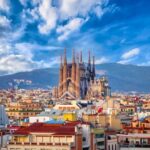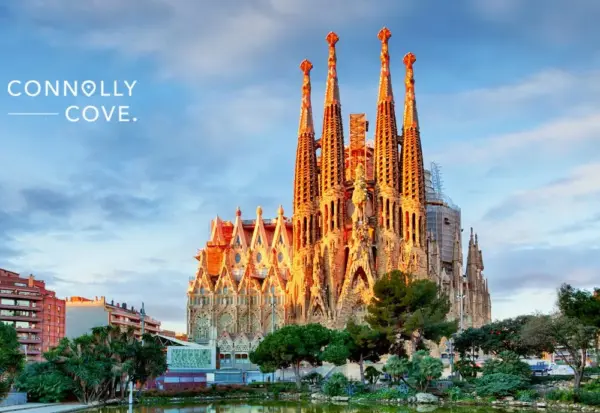
Barcelona, a city known for its rich history and vibrant culture, is home to one of the most extraordinary architectural marvels in the world: the Sagrada Familia. This iconic basilica, designed by the brilliant architect Antoni Gaudí, encapsulates the essence of Catalan Modernism and has become a symbol of the city itself.
In this article, we will delve into the fascinating details of this masterpiece, unveiling the artistic genius behind its intricate facades and towering spires. Join us on a journey through The Majestic Sagrada Familia: Exploring Barcelona's Iconic Landmark, where every stone tells a story and every curve reflects Gaudí's vision of a divine creation.
The History and Architectural Significance of the Sagrada Familia
The history of the Sagrada Familia dates back to 1882, when construction first began under architect Francisco de Paula del Villar. However, it was Gaudí, who took over the project in 1883, that transformed the basilica into a unique expression of art and architecture. His innovative designs blended Gothic and Art Nouveau styles, creating a structure that is as much a sculpture as it is a building. Today, it remains unfinished, with an anticipated completion date around 2026, marking the centenary of Gaudí's death.
Architecturally, the Sagrada Familia stands out for its intricate detail and symbolic elements. The basilica features three grand facades, each representing a different aspect of Christ's life: the Nativity, the Passion, and the Glory. These facades are adorned with intricate sculptures that narrate biblical stories and reflect Gaudí's devotion to his faith. Additionally, the interior is designed to resemble a magical forest, with columns that mimic tree trunks, creating a sense of harmony with nature.
The use of light within the Sagrada Familia is another remarkable feature. Gaudí ingeniously incorporated stained glass windows that filter sunlight into a spectrum of colors, enhancing the spiritual ambiance of the space. This play of light not only illuminates the interior but also serves to elevate the worship experience, making visitors feel as if they are entering a sacred realm. The following aspects highlight its significance:
- Innovative geometry: The use of hyperboloids and paraboloids creates a dynamic structure.
- Natural motifs: Elements inspired by nature are prevalent throughout the design.
- Structural ingenuity: The basilica incorporates cutting-edge engineering techniques for its time.
Visiting the Sagrada Familia: What You Need to Know
Visiting the Sagrada Familia is an unforgettable experience, but it's essential to plan ahead. To make the most of your visit, consider purchasing your tickets online to avoid long queues. The official website often offers various options, including guided tours that provide deeper insights into Gaudí's vision and the basilica's intricate details.
When you arrive, be prepared for security checks and ensure you dress respectfully, as this is a place of worship. It's advisable to allocate at least 1.5 to 2 hours to fully appreciate both the interior and exterior. Here are a few tips to enhance your visit:
- Best time to visit: Early morning or late afternoon when the light creates stunning effects through the stained glass.
- Audio guides: Available for rent, providing valuable context and commentary about the artwork and architecture.
- Photography: Be mindful of the rules regarding photography, especially during mass services.
Lastly, consider exploring the surrounding area, including the nearby Park Güell, another of Gaudí's masterpieces. This vibrant park complements the Sagrada Familia's unique aesthetics and offers additional opportunities to enjoy Barcelona’s rich cultural heritage. With these tips in mind, your visit to the Sagrada Familia will surely be a remarkable part of your journey through Barcelona.
Uncovering the Symbolism Behind Sagrada Familia's Design
The design of the Sagrada Familia is steeped in symbolism, with each element meticulously crafted to convey deeper meanings. Gaudí sought to encapsulate the divine nature of Christ through architectural elements that reflect both his faith and reverence for the natural world. Among the most significant symbols are:
- The Tree of Life: The columns in the basilica mimic trees, symbolizing the connection between heaven and earth.
- Light as Divinity: The play of light through stained glass represents the presence of God, illuminating the sacred space.
- The Number Three: Frequently appears in the design, symbolizing the Holy Trinity—Father, Son, and Holy Spirit.
Furthermore, the facades of the Sagrada Familia convey distinct narratives from the life of Christ. The Nativity facade, for example, is rich in detail, depicting the birth of Jesus and highlighting the joy and wonder of this moment. In contrast, the Passion facade presents a more somber tone, reflecting the suffering and sacrifice of Christ. This juxtaposition of joy and sorrow serves to engage visitors in a profound spiritual experience, inviting contemplation and reflection.
Gaudí's architectural choices also embody a harmonious relationship with nature, evident in the organic shapes and forms throughout the basilica. By integrating natural motifs, he aimed to create a sanctuary that resonates with the surrounding environment, emphasizing the importance of creation in the spiritual journey. This blend of the natural and the divine is a hallmark of Gaudí’s genius, making the Sagrada Familia a true testament to his artistic vision.
In addition to its visual symbolism, the Sagrada Familia incorporates advanced engineering techniques that represent Gaudí’s innovative spirit. The use of catenary arches and hyperbolic paraboloids not only adds to the aesthetic appeal but also enhances structural stability. Understanding these elements provides further insight into Gaudí's intent to create a lasting monument that transcends mere architecture, embodying a living expression of faith.
A Guide to the Best Views of Barcelona's Sagrada Familia
For those seeking the best views of Barcelona's Sagrada Familia, several locations offer stunning perspectives that capture the basilica's grandeur. One of the most popular spots is the Plaça de Gaudí, a park located directly across from the basilica. Here, visitors can enjoy a panoramic view of the basilica's intricate facades, framed by lush greenery and vibrant flowers, making it an ideal photo opportunity.
Another fantastic vantage point is the rooftop of the Casa Mila, also known as La Pedrera. This Modernist building, designed by Gaudí, provides an elevated perspective of the Sagrada Familia against the backdrop of the Barcelona skyline. The rooftop's unique chimneys add an artistic touch to your photographs.
For a more adventurous view, consider hiking up to the Turó de la Rovira, a former anti-aircraft bunker that offers breathtaking panoramic views of the entire city, including the Sagrada Familia. This hidden gem is less crowded and provides a unique opportunity to see the basilica from a distance, set against the sprawling urban landscape.
Lastly, the Barcelona Cathedral in the Gothic Quarter offers a different angle of the Sagrada Familia. From its rooftop, visitors can appreciate the contrast between the two iconic structures, highlighting Barcelona's diverse architectural heritage. Be sure to capture these moments, as each location provides a unique narrative of Gaudí’s masterpiece.
Sagrada Familia: Gaudí's Masterpiece and Its Cultural Impact
The Sagrada Familia stands as a testament to Antoni Gaudí's genius, blending architecture with spirituality. This iconic landmark has not only reshaped the skyline of Barcelona but has also influenced modern architecture worldwide. Gaudí's use of natural forms, innovative engineering, and profound symbolism within the Sagrada Familia has inspired countless architects and artists, making it a beacon of architectural creativity and a symbol of cultural identity.
Moreover, the cultural impact of the Sagrada Familia extends beyond its physical structure. It serves as a pilgrimage site for many, drawing millions of visitors annually who come to experience its unique spiritual atmosphere. The basilica's continuous construction has become a symbol of perseverance and dedication, reflecting Gaudí's vision that transcends time. This enduring project has fostered a sense of community among those involved in its construction and among visitors who share in its story.
In addition to its artistic and architectural significance, the Sagrada Familia plays a crucial role in promoting Catalan culture and heritage. As an emblem of Catalonia, it embodies the region's artistic achievements and has become a focal point of pride for its residents. Events and exhibitions related to its construction and history often highlight the importance of preserving local traditions and craftsmanship, ensuring that Gaudí's legacy continues to inspire future generations.
Finally, the Sagrada Familia has positioned Barcelona as a global cultural destination, contributing significantly to the city's economy through tourism. The influx of visitors eager to witness Gaudí's masterpiece has spurred the development of surrounding businesses, enhancing the overall cultural landscape. As the Sagrada Familia nears completion, its ongoing influence on the world of art, architecture, and culture is certain to leave a lasting imprint on both Barcelona and beyond.
Tips for Exploring Sagrada Familia and the Surrounding Area
When exploring the Sagrada Familia, it’s essential to plan your visit strategically. To avoid the bustling crowds, aim to arrive early in the morning or late in the afternoon. This timing not only enhances your experience but also allows you to witness the mesmerizing effects of natural light filtering through the stunning stained glass windows. Consider booking tickets online in advance, as this will save you time and ensure a smoother entry into this architectural wonder.
While the Sagrada Familia itself is a breathtaking sight, the surrounding area offers additional delights worth exploring. Take a leisurely stroll through the nearby neighborhoods, where you can discover charming cafés and local shops. Here are a few attractions to include in your itinerary:
- Park Güell: Another Gaudí creation, this colorful park is filled with whimsical designs and provides picturesque views of Barcelona.
- Casa Batlló: A masterpiece of modernist architecture, located not far from the basilica, featuring Gaudí's signature style.
- La Pedrera: Also known as Casa Mila, this iconic building showcases Gaudí's brilliance and offers guided tours.
Don’t forget to immerse yourself in the local culture while you explore! Sampling traditional Catalan dishes at nearby restaurants will enhance your experience. Look for local specialties such as pa amb tomàquet (bread with tomato) and crema catalana, which are must-tries when in the city. This culinary adventure will complement your visit to the Sagrada Familia and provide a deeper understanding of the region’s rich heritage.
Lastly, keep an eye out for the various guided tours available around the Sagrada Familia. These often include insightful commentary on Gaudí’s architectural techniques and the basilica's symbolism. Whether you choose a walking tour or a dedicated guided experience, these options can significantly enrich your visit, allowing you to appreciate the artistry and devotion embedded in every detail of this magnificent landmark.
 Barrio Life: Unique Neighborhood Culture
Barrio Life: Unique Neighborhood Culture Smooth Transfers: From Sagrada Familia to Barcelona Airport - A Guide for Travelers
Smooth Transfers: From Sagrada Familia to Barcelona Airport - A Guide for TravelersIf you want to know other articles similar to The Majestic Sagrada Familia: Exploring Barcelona's Iconic Landmark you can visit the category WHERE YOU CAN GO.
Leave a Reply










Read more!